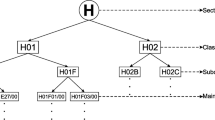Abstract
Patent classifications are built to set up some order in the growing number and diversity of inventions, and to facilitate patent information searches. The need to automate classification tasks appeared when the growth in the number of patent applications and of classification categories accelerated in a dramatic way. Automated patent classification systems use various elements of patents’ content, which they sort out to find the information most typical of each category. Several algorithms from the field of Artificial Intelligence may be used to perform this task, each of them having its own strengths and weaknesses. Their accuracy is generally evaluated by statistical means. Automated patent classification systems may be used for various purposes, from keeping a classification well organized and consistent, to facilitating some specialized tasks such as prior art search. However, many challenges remain in the years to come to build systems which are more accurate and allow classifying documents in more languages.
Similar content being viewed by others
Notes
- 1.
http://en.wikipedia.org/wiki/Zipf’s_law. Accessed 23 Dec 2010.
- 2.
http://en.wikipedia.org/wiki/Precision_and_recall. Accessed 23 Dec 2010.
Abbreviations
- AI:
-
Artificial Intelligence
- APC:
-
Automated Patent Classification
- ECLA:
-
European Patent Classification
- EPO:
-
European Patent Office
- IPC:
-
International Patent Classification
- kNN:
-
k Nearest Neighbors
- MCD:
-
Master Classification Database
- NN:
-
Neural Network
- PCT:
-
Patent Cooperation Treaty
- SVM:
-
Support Vector Machine
- WIPO:
-
World Intellectual Property Organization
References
Sebastiani F (2002) Machine learning in automated text categorization. ACM Comput Surv 34(1):1–47
Berry MW, Castellanos M (eds) (2007) Survey of text mining: clustering, classification, and retrieval. Springer, Berlin
Fall CJ, Törcsvári A, Benzineb K, Karetka G (2003) Automated categorization in the international patent classification. SIGIR Forum 37(1)
Fall CJ, Benzineb K, Guyot J, Törcsvéri A, Fiévet P (2003) Computer-assisted categorization of patent documents in the international patent classification. In: Proceedings of the international chemical information conference (ICIC’03), Nîmes, France, Oct 2003
Proceedings of the CLEF-IP 2010 (classification task), to be published in 2011. The related web site is here: http://www.ir-facility.org/research/evaluation/clef-ip-10. Accessed 23 Dec 2010
Further Reading
WIPO’s website page dedicated to international patent classifications (IPC, Nice, Locarno, Vienna): http://www.wipo.int/classifications/en/. Accessed 23 Dec 2010
EPO’s website page dedicated to ECLA: http://test.espacenet.com/ep/en/helpv3/ecla.html. Accessed 23 Dec 2010
World Patent Information, Elsevier: an International Journal for Industrial Property Documentation, Information, Classification and Statistics (Quarterly)
Author information
Authors and Affiliations
Corresponding author
Editor information
Editors and Affiliations
Rights and permissions
Copyright information
© 2011 Springer-Verlag Berlin Heidelberg
About this chapter
Cite this chapter
Benzineb, K., Guyot, J. (2011). Automated Patent Classification. In: Lupu, M., Mayer, K., Tait, J., Trippe, A. (eds) Current Challenges in Patent Information Retrieval. The Information Retrieval Series, vol 29. Springer, Berlin, Heidelberg. https://doi.org/10.1007/978-3-642-19231-9_12
Download citation
DOI: https://doi.org/10.1007/978-3-642-19231-9_12
Publisher Name: Springer, Berlin, Heidelberg
Print ISBN: 978-3-642-19230-2
Online ISBN: 978-3-642-19231-9
eBook Packages: Computer ScienceComputer Science (R0)




